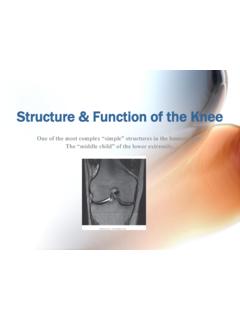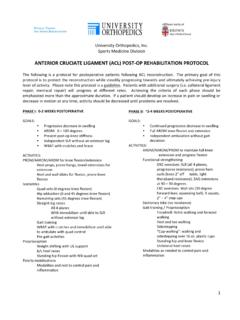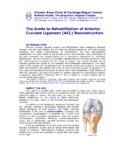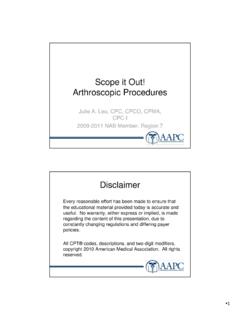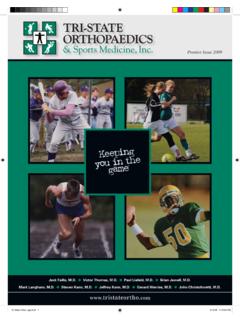Transcription of Approach to Knee Effusions - Orthosports
1 Approach to knee EffusionsDavid J. Mathison, MD* and Stephen J. Teach, MD, MPH* Abstract:The presence of an intra-articular knee effusion requires anextensive differential diagnosis and a systematic diagnostic knee Effusions occur most commonly as acute hemarthrosesafter traumatic injury. However, the knee joint is susceptible to effusionssecondary to a wide variety of atraumatic causes. Special attention isrequired in the atraumatic effusion to distinguish features of infectious,postinfectious, rheumatologic, hematologic, vasculitic, and malignantdisease. This review discusses the various etiologies of both traumaticand atraumatic pediatric knee Effusions highlighting the historical, phy-sical examination, and laboratory characteristics to aid the emergencyprovider in diagnosis and initial Words: knee effusion , knee injury, septic arthritis, joint effusion ,fracture, anterior cruciate ligament, patellar dislocation, arthrocentesis,Lyme disease(Pediatr Emer Care2009;25: 773Y790)TARGET AUDIENCEThis CME activity is intended for physicians, nurse prac-titioners, and physician assistants who care for children in anemergency or primary care OBJECTIVESA fter participating in the activity, the paticipant shouldbe better able to:1.
2 Outline a pragmatic Approach to the child and adolescentwith either an acute or a chronic knee Use distinguishing historical and physical examination fea-tures to differentiate causes of traumatic knee Describe various etiologies of atraumatic Effusions and theimportant laboratory and radiographic features that can aidin CASESA 14-year-old adolescent boy presents to the emergencydepartment after injuring his knee playing soccer. He recallspivoting and twisting his right knee , then hearing aBpop.[Hewas unable to bear weight at the scene and was subsequentlycarried off the field. On examination, he has no obviousdeformity but has a large effusion in his right knee with limitedflexion.]
3 An anterior drawer test is limited by pain and swelling,but there is laxity on the Lachman maneuver. Results of both theMcMurray test and the Bounce test are positive. His collateralligaments appear intact, and his patella does not appear to besubluxable. A radiograph of his knee is negative for fracture 15-year-old adolescent girl presents to the emergencydepartment with several weeks of worsening left knee pain. Shedenies fevers, foreign travel, sexual activity, or other jointsymptoms. She spent the recent summer camping although hasno known tick exposures. She has family members with lupus,but she is otherwise healthy and takes no medications. On exa-mination, she has limited flexion of her knee .
4 There is notableswelling with a fluid wave appreciated in the suprapatellarpouch. There is no warmth or erythema. A lateral radiographshows signs of an effusion , but there are no bony abnormali-ties. The remainder the results of her physical examination knee complaints are frequent in the pediatricemergency department, particularly among adolescent athleteswho injure the knee more than any other body part, exceptthe knee pathologic diseases are related to mi-nor trauma such as muscle strains, ligamentous sprains, andapophyseal overuse injuries. Patients with large knee Effusions ,however, are distinct. Although these Effusions are most fre-quently hemarthroses from acute traumatic injuries, the clinicianneeds a broad differential to exclude the various nontraumaticcauses of knee Effusions specific to the pediatric patient (Table 1).
5 HISTORYP atients with large Effusions often have painful joints thatare difficult to examine. It is therefore crucial to obtain athorough history to elucidate risk factors for certain clinician should ascertain information about acuity,duration, severity, signs of systemic disease, associatedsymptoms, and risk factors for various diseases. Examples ofhistorical questions include the following:&Is the swelling acute, subacute, or chronic?&Has there been a traumatic event or repeated overuse?&Are other joints involved?&Are there signs of systemic illness (fevers, rash, etc)?&Has there been recent travel to high-risk areas (ie, Lyme,brucellosis, tuberculosis)?&Has there been any exposure to ticks?
6 &Have any new over-the-counter, herbal, or prescriptionmedicines been used?&Have there been any recent unprotected sexual encounters?&Is there a coexisting chronic illness (ie, inflammatory boweldisease [IBD], lupus)?&Is there a history of injury or surgery to the joint?&Is there a family history of rheumatologic or autoimmunedisease?CME REVIEWARTICLEP ediatric Emergency Care&Volume 25, Number 11, November *Fellow (Mathison), Associate Chief (Teach), Division of EmergencyMedicine, Children s National Medical Center; and Instructor in Pediatrics(Mathison), Professor of Pediatrics and Emergency Medicine (Teach), GeorgeWashington School of Medicine and Health Sciences, Washington, : David J.
7 Mathison, MD, Division of Emergency Medicine,Children s National Medical Center, 111 Michigan Ave NW, Washington,DC 20010 (e-mail: otherwise noted below, each faculty s spouse/life partner (if any) hasnothing to authors have disclosed that they have no significant relationship with orfinancial interests in any commercial companies that pertain to thiseducational staff in a position to control the content of this CME activity havedisclosed that they have no financial relationships with, or financialinterests in, any commercial companies pertaining to this CME Institute has identified and resolved all faculty conflicts ofinterest regarding this educational *2009 by Lippincott Williams & WilkinsISSN: 0749-51619 Copyright @ 200 Lippincott Williams & Wilkins.)
8 Unauthorized reproduction of this article is of descriptive questions specific to a traumaticevent include the following:&Was the injury a contact or a noncontact injury?&What was the joint position during injury (ie, flexion,extension)?&What was the mechanism of injury (ie, cutting, pivoting,twisting)?&Have there been any mechanical symptoms (ie, locking,popping, or catching)?&Was there any ability to bear weight after the injury?&Have there been signs of instability (ie,Bgiving-way[)?&Where is the location of the pain?ANATOMYThe knee is the largest joint in the body. It is formed by 3articulations: the medial femoral and tibial condyles, the lateralfemoral and tibial condyles, and the patella (Fig.)]
9 1). There are4 majorligamentsthat provide stability: the anterior and pos-terior cruciate ligaments (ACL and PCL, respectively), whichprevent dislocation of the tibia against the femur, and the me-dial and lateral collateral ligaments, which withstand medial andlateral stressors. The majormuscle groupssurrounding the kneeare the quadriceps, the hamstring, the plantaris, the popliteus,and the gastrocnemius. The quadriceps femoris is the principalcomponent for leg extension and one of the most powerfulmuscle groups in the body. It is composed of 4 parts: rectusfemoris, vastus lateralis, vastus intermedius, and vastus medi-alis. Leg flexion is principally accomplished by the hamstrings,composed of the semitendinosus, semimembranosus, and bi-ceps femoris muscles.
10 The popliteus, plantaris, and gastrocne-mius all offer additional support in leg s anterior position allows the quadriceps tendonto insert further from the joint s axis thus creating additionaljoint leverage. This mechanical advantage allows the joint towithstand friction from flexion and extension during runningand to withstand compression of the quadriceps tendon duringkneeling. Themenisci(from the Greek wordmeniskos, meaningcrescent) are wedge-shaped plates of fibrocartilage that act asshock absorbers for knee movements. The menisci are bridgedby the transverse ligament of the knee , which allows them tomove together during knee motion. The medial collateralligament at its midpoint inserts into the medial meniscus,helping to explain why injuries to this ligament often haveconcomitant meniscal tearing.






